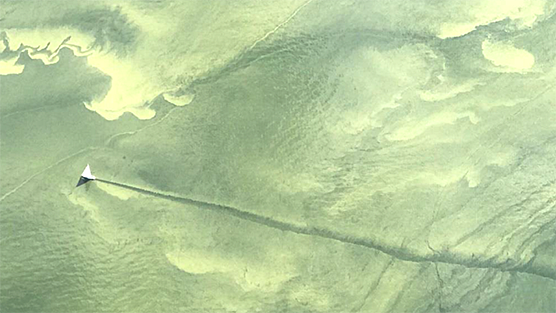Press release 2019-07-25 at 16:15
Since 1990, the Baltic Sea has on average warmed by almost 2 °C, Finnish sea areas even more than that. Nutrient pollution has continued to visibly decrease on this millennium but the surface area of anoxic seabed is at an all-time high.

Cyanobacterial blooms in the Gulf of Finland in summer 2018. © Finnish Border Guard
According to HELCOM (Baltic Marine Environment Protection Commission), the annual average surface temperature of the Baltic Sea rose to an all-time high last year. The highest recorded temperature on open Baltic (27°C) was measured exactly a year ago on July 25, 2018. In the last 100 years, the Baltic Sea has warmed 0.3°C per decade, however after 1990 significantly faster at 0.59°C per decade. The amount of blue-green algae has statistically significantly increased in open sea areas in the Gulf of Finland, Sea of Åland and the Sea of Bothnia in the last approximately 40 years.
Average temperature of sea water in Utö at the depth of 5, 50 and 90 metres

© Laakso ym. 100 years of atmospheric and marine observations at the Finnish Utö Island in the Baltic Sea. Ocean Sci., 14, 617-632, 2018. https://doi.org/10.5194/os-14-617-2018
Record-breaking anoxic areas
Anoxic seabed areas have increased 10-fold since the beginning of the 20th century which is mainly due to the accelerated eutrophication by nutrient pollution caused by humans. According to SMHI (Swedish Meteorological and Hydrological Institute), the area of anoxic seabed became higher than ever in 2018. In the last decades, the negative development has been exacerbated by rapid warming of the sea. Warm water is less capable of absorbing oxygen while accelerating decomposition which requires a lot of oxygen. Under anoxic conditions, large amounts of phosphorus are released from the bottom sediment of the sea, feeding blue-green algae blooms.
According to an article published last year in Science journal, the anoxic water mass in the world’s marine areas has quadrupled after 1950. The reasons are similar as in the Baltic Sea: nutrient pollution and global warming caused by humans.
Nutrient pollution continues to be too high
Despite decreased phosphorus (-25%) and nitrogen (-12%) pollution in the Baltic Sea even after the turn of the millennium, nutrient pollution still exceeds HELCOM's goals set in the 2013 ministerial meeting. In order to reach the goal in Finland, better management of release of agricultural nutrients is in the focal point. Meanwhile nutrient pollution from point sources has significantly decreased in Finland in the last decades, measures to control diffuse pollution have only had moderate results.
Last year, the Ministry of the Environment launched a three-year programme (2019-2021) to enhance the effectiveness of water protection, and over a half of its 45 million euro budget has been allocated to new innovative methods in agricultural water protection. However, in order to completely reach the set goal, existing agricultural water protection methods must also be enhanced and better targeted.
Carbon and nutrient footprint of consumption unsustainably high
In addition to cutting down nutrient pollution, rapid measures to control global warming are needed in order to achieve the good environmental status of the Baltic Sea. In Finland, household consumption comprises two thirds of consumption-based greenhouse emissions. The Finnish carbon footprint has increased by 12% since 2000. The increase in household consumption overshadows the benefits had from the commissioning of more environmentally friendly technology. Policy measures are needed to manage consumption and to cut consumption-based emissions in order to guide households to choose goods and services with a low carbon footprint.
On average, 60% of the Baltic Sea footprint of a Finn comes from food production. According to the results of the FoodMinimum project led by Luke (Natural Resources Institute of Finland) and SYKE, reducing the consumption of animal-based products reduces the climate and eutrophication effects of diet. At the moment about 70% of all cultivated land in Finland is used for the production of animal-based food. The easiest way for an average consumer to cut total emissions is to eat more vegetables and domestic wild fish. That would decrease the need for cultivated land.
Monitoring the state of the Baltic Sea
SYKE’s marine research vessel Aranda gathers information around the entire Baltic Sea. Monitoring is carried out in collaboration with i.e. the Swedish SMHI. Automatic measuring devices installed in trade vessels monitor the temperature of surface water as well as the salinity and the amount of algae in real time. In addition, satellite images are utilised to assess the condition of the sea. Only continuous long-term monitoring activities can ensure accurate assessments of the effectiveness of sea protection measures and make sure that investments towards improvements of the condition of the sea are targeted correctly.
More Information
Senior Research Scientist Seppo Knuuttila, Suomen ympäristökeskus SYKE
Tel. +358 295 251 286, firstname.lastname@ymparisto.fi
SYKE has also published today this week's algal bloom monitoring: July 25, 2019: Cyanobacteria have further increased in the Finnish sea areas and lakes